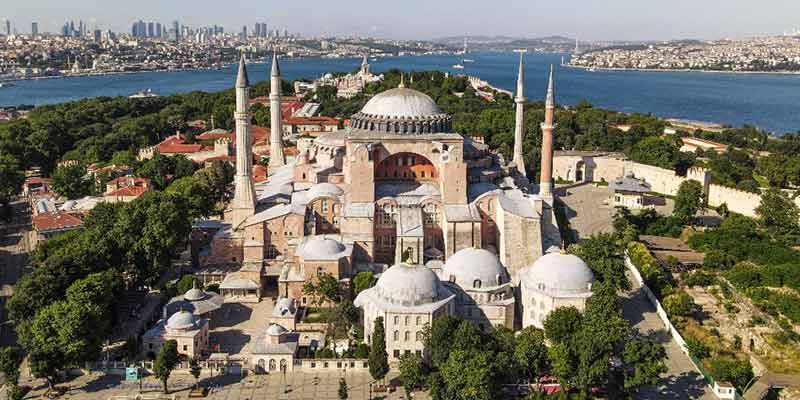- World
- Jul 11
Turkey turns Hagia Sophia into mosque
Turkish President Recep Tayyip Erdogan announced that the Hagia Sophia, one of the architectural wonders of the world, would be reopened for Muslim worship as a mosque, sparking fury in the Christian community and neighbouring Greece.
His declaration came after a top Turkish court revoked the sixth-century Byzantine monument’s status as a museum, clearing the way for it to be turned back into a mosque.
In an address to the nation, Erdogan said the first Muslim prayers at the Hagia Sophia would be performed on July 24.
The UNESCO World Heritage site in historic Istanbul is a magnet for tourists worldwide. Last year, 3.8 million tourists visited the monument.
History of Hagia Sophia
According to Byzantine historians, the first building of Hagia Sophia church was established during the reign of Constantius I (324 – 337 AD). It was a basilica with a wooden roof, and it was burned down during a revolt.
During the reign of emperor Theodosius, Hagia Sophia was built for the second time and opened to the public in 415 AD. The basilica was again burned down during the Nika Revolt in 532 AD.
Emperor Justinian (527–565 AD) wanted to build a church bigger than two previous ones, which would represent the power and magnificence of the empire. The new building of Hagia Sophia was designed by two famous architects of that era. The works commenced in 532 AD and completed in 537.
Besides the unique architecture of the building, the mosaics are also important artefacts of the period.
It was turned into a mosque by Sultan Mehmet II following the 1453 Ottoman conquest of Constantinople — the city that is now called Istanbul.
The Ottomans built minarets alongside the vast domed structure and inside they added panels.
In 1934, a Cabinet decision turned the site into a museum.
Hagia Sophia Museum was opened in 1935 and ever since it has been attracting lakhs of visitors every year.
The golden mosaics and Christian icons, obscured by the Ottomans, were uncovered again when Hagia Sophia became a museum.
Court overturns Cabinet decision
Turkey’s high administrative court threw its weight behind a petition brought by a religious group and annulled the 1934 Cabinet decision that turned the site into a museum.
In its ruling the Council of State, Turkey’s top administrative court, said: “It was concluded that the settlement deed allocated it as a mosque and its use outside this character is not possible legally. The cabinet decision in 1934 that defined it as a museum did not comply with laws,” it said.
Within hours, President Recep Tayyip Erdogan signed a decree handing over Hagia Sophia to Turkey’s Religious Affairs Presidency.
How UNESCO responded to the move?
The United Nations Educational, Scientific and Cultural Organisation (UNESCO) has voiced deep regret over Turkey’s decision made without prior discussion, saying its status as a museum reflects the universal nature of its heritage and makes it a powerful symbol for dialogue.
“Hagia Sophia is an architectural masterpiece and a unique testimony to interactions between Europe and Asia over the centuries. Its status as a museum reflects the universal nature of its heritage, and makes it a powerful symbol for dialogue,” UNESCO director-general Audrey Azoulay said.
What were the reactions by other countries?
The landmark ruling could inflame tensions not just with the West and Turkey’s historic foe Greece but also Russia, with which Erdogan has forged an increasingly close partnership in recent years.
Greece swiftly condemned the move by Muslim-majority Turkey as a provocation while the United States also expressed disappointment.
“Greece condemns most firmly” the decision, said Prime Minister Kyriakos Mitsotakis, adding “it does not only impact relations between Greece and Turkey but also the latter’s relations with the European Union, UNESCO and the global community as a whole.”
US State Department spokeswoman Morgan Ortagus stated that “we are disappointed by the decision by the government of Turkey to change the status of the Hagia Sophia”.
Manorama Yearbook app is now available on Google Play Store and iOS App Store

